View current page
...more recent posts
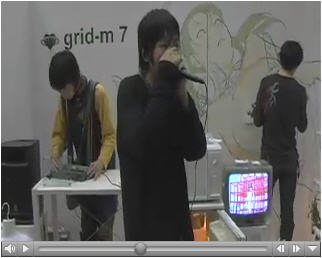

Follow this link to the above performance by grid-m 7. I know next to nothing about the event except it's (a) in Japan, (b) at "Design Festa," which is some kind of festival where artists can rent space (don't know why there are kitchenwares in the band's "set") and (c) has some artwork on the TV monitor by Ryuko Azuma, who I posted about recently (don't know who is painting the apparently topless cutie on the back wall, but she's very nicely drawn). The video goes on a bit too long but some of the human beatbox moves are great. What cracks me up is the vibe of the utopian Total Artwork (with beatniks). You got your human beatbox. You got your DJ with wild synthesis effects. You got your video screen. You got your live painting...
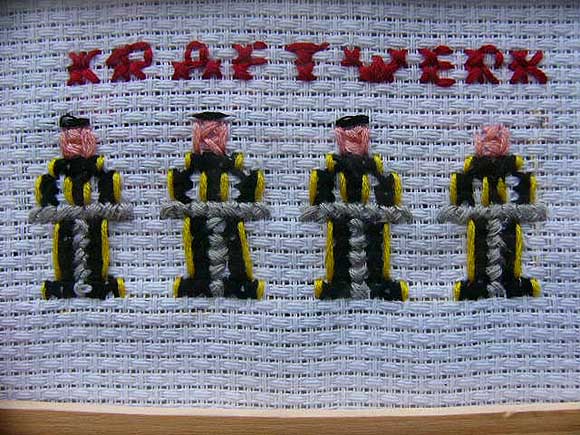
Kraftwerk stitch by the daughter of co-founding member Florian Schneider. Her dad is the guy at the end with no coiffure.
After posting about the rash of hardware synth sequencer performances on YouTube and speculating that it might be a micro-genre in the making, I noticed Cory Arcangel had a series of del.icio.us links to Ed DMX's website, which is chock a block with pictures of mostly '80s gear and the sounds they produce. Some great stuff there. (Like this .mp3.)
What we're seeing, I think, is the reaction to what DMX calls "the computer revolution" in music production. There's almost no function of old gear that your laptop and a good soundcard can't do better and more imaginatively nowadays, so inevitably the outmoded becomes fetishized.
It's ironic that the sequencer, a piece of gear that generates MIDI patterns for synths to play, was yesterday's soul deadening "end of music as we know it," but now that it's been made superfluous by software--honestly, nothing is easier for your computer to do than generate MIDI notes--it is all about "warmth" and "hands-on playing."
Not saying that analog synthesis lacks romance. I'm guilty of spending hours surfing old synth sites and have recently plunked down for a couple of pieces of such gear, but have mostly not succumbed to the urge to fill up my apartment with power-hogging, space-occupying, hard-to-transport machinery.
And I'm not saying that watching someone play a hardware sequencer live isn't superior to watching a performer stroke a laptop thumbpad. (Although, done badly, which they usually are, "sequencer workouts" quickly devolve into boring new age music.) And I'm not suggesting that the crackly, juiced up voltages of analog synths aren't sexy as hell.
But perhaps we need to separate what's irreplaceable about the "old new ways" from our kneejerk reaction to the "new new ways." Former computerphobe Brian Eno is selling off his gear--that's a good, positive role model for everyone. Small is beautiful.

Pong on the Akai MPC1000 sampler
I have no idea how hard or significant it is that someone put a pong game on a sampler's LCD. But I like this animated GIF.
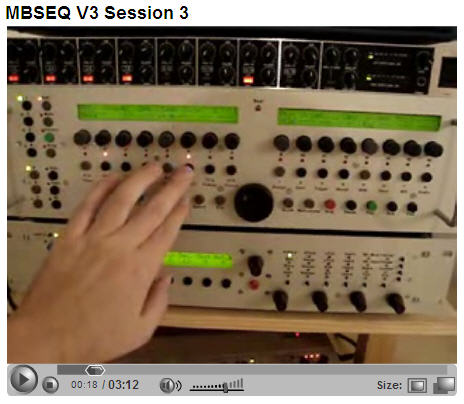
Midibox V3 SEQ demonstration
[YouTube]
via
"Hardware Sequencer Demos" appears to be a happenin' genre on YouTube. Here's a home-built unit in action.
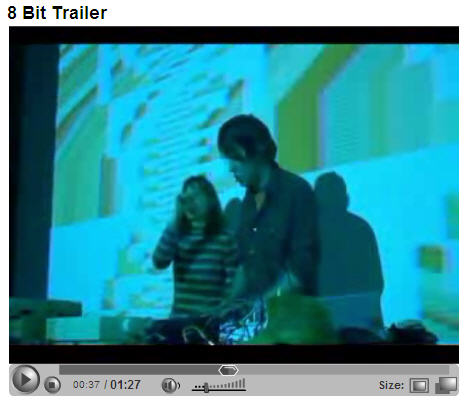
The movie 8 BIT: A Documentary about Art and Videogames, which I discussed here last winter, premieres at the Museum of Modern Art on October 7, 2006. The film has a website, and you can view a trailer here (YouTube) or here (Quicktime). This is what I posted about it previously:
Last night vertexList gallery hosted a semi-private screening of the documentary film 8 BIT, directed by the gallery's proprietor Marcin Ramocki and produced by Justin Strawhand, who did the cinematography. The subject is art and the video game, but several distinct cultures and subcultures overlap: the big three being conceptual art, gamers, and electronic music but also the demoscene, chiptunes, gameboy music, and miscellaneous odd hacks. It's a PBS-quality collection of talking head interviews (including yours truly wearing a suit jacket and doing his best critic impersonation), interspersed with concert footage, video clips, and a kaleidoscope of stills that underscore and comment on things being said in the interviews.Expect more plugs as the date approaches.
Highlights include the stage appearances of Tree Wave [above photo] and Bodenstandig 2000 at Jeffrey Deitch last spring, Cory Arcangel discoursing on Nintendo cracking and the different types of synthesizer sounds in '80s computers, Alex Galloway's explanation of his Nam Jun Paik-like physical hacks bringing out the inherent flaws and coding errors in console games, footage from Eddo Stern's trippy, deconstructed Vietnam war game landscapes, Joe McKay on Audio Pong and the attempted or presumed realism of early hockey games, and it must be said, my withering putdown of gameboy music followed by Nullsleep telling me to fuck off from the stage at Deitch. A movie with an eternally adolescent pursuit at its core just wouldn't be complete without a good food fight.
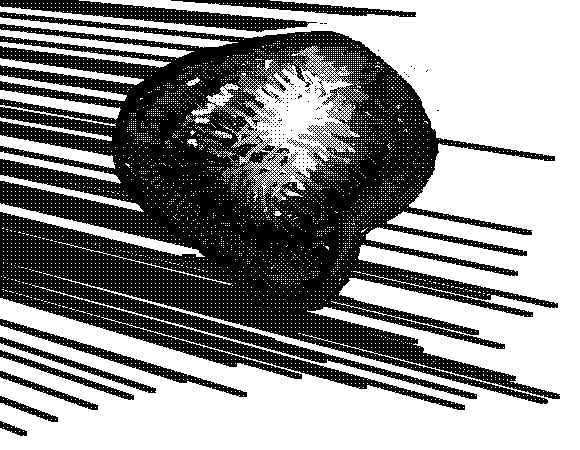
Frank Zappa plays bicycle on Steve Allen. I know this has been through a couple of rounds of linkage, but it's a must-see, especially if you like Zappa. As a square-looking, preternaturally calm 22 year old, before the long hair and "freak" trappings appeared, his contradictions are strikingly clear. A condescending snot, with a streak of incredible generosity who wanted everyone to be a musician. An arch-controller spouting facts and statistics, who loved to instigate all-hell-breaks-loose chaos scenarios that were an absolute blast for everyone involved. A great American artist, more sadly missed than ever.
Update: YouTubes removed for "terms of use violation." More of our heritage flushed...for what reason exactly? YouTube is a joke.
Update: Sigh, it's back up again, worse quality. [Part 1 of 4]
Paul has spotted DEVO 2.0 at Disney online. It's kids lipsynching to fairly tight, "family friendly" versions of the songs, with backing tracks re-recorded by the original band. As Paul notes, the lyrics have been changed: it's not just taking out the dirty words, but "removing or reversing their original core meaning."
I watched the "Freedom of Choice" vid and I don't think I can go on. It's well done and fun, and you can't fault DEVO for selling out--in essence, they inoculated themselves from that criticism early on by tying their concept of "Devolution" to a general decline in culture and intelligence, INCLUDING becoming commercial hacks--"We're devolving, see?"
But as an early fan of the band it's just too painful to hear the lines "Freedom of choice is what you've got/Freedom from choice is what you want" changed so that the "from" in the second line becomes a second "of." Or the lyric about the dog "who sniffs one bone, then licks the other, then spins in circles till he drops dead" changed to "he drops down."
Choice killed the dog, OK? Is that too much for a kid to grasp?
How many times can someone steal that same vase?
From the Guardian:
Saviour of Iraq's antiquities flees to SyriaFreedom is untidy.
Michael Howard in Irbil
Saturday August 26, 2006
Iraq's most prominent archaeologist has resigned and fled the country, saying the dire security situation, an acute shortage of funds, and the interference of supporters of the radical Shia cleric Moqtada al-Sadr had made his position intolerable.Donny George, who was president of the State Board of Antiquities and Heritage, achieved international recognition for his efforts to track down and recover the priceless antiquities looted from Iraq's National Museum in the mayhem that followed the fall of Baghdad in 2003.
But this week he revealed that he had resigned and was in hiding with his family in the Syrian capital Damascus. In an interview with the Art Newspaper, Dr George said Baghdad was now so dangerous that the National Museum, which houses a trove of Sumerian and Babylonian artefacts, had been sealed off by concrete walls to protect it from insurgent attacks and further looting.
The museum, established by the British in the 1920s, is situated near to Baghdad's notorious Haifa Street, an area that sees regular outbreaks of violence. It lost some 15,000 pieces during the looting in 2003, but about half of them have been recovered. Museum officials say the collections have been walled off four times since the invasion, most recently after a mass kidnapping near the museum building.
"It was the only way to guarantee the museum's safety," said Dr George, who said he had taken the decision despite opposition from the culture ministry. An indefinite delay in the reopening of the museum had been ordered by the ministry.
Dr George painted a bleak picture for the future of Iraq's ancient treasures. He said that excavation and conservation projects in Iraq had stalled and that all the foreign archaeologists had left the country.
He said the 1,400 members of the special antiquities protection force would be going without pay, meaning there would be little to stop further looting at the country's 11,000 archaeological sites. "From September there is no more money for their salaries," said Dr George. "The coalition has to do something about this."
After the looting in 2003 US officials were criticised by archaeologists for not securing the museum. The US military has since been accused of damaging a number of ancient sites. Dr George said the work of the antiquities department had also been affected by the sectarian divide in Iraq, with key posts in the culture ministry being filled with loyalists of the militant Shia cleric Moqtada al-Sadr, including Liwa Sumaysim, the minister of state for antiquities.
"The board has come under the increasing influence of al-Sadr," claimed Dr George. "I can no longer work with these people who have come in with the new ministry. They have no knowledge of archaeology, no knowledge of antiquities."
Dr George, a Christian, said he had battled to prevent an Islamist and anti-western agenda from taking over at the antiquities department. "A lot of people have been sent to our institutions. They are only interested in Islamic sites and not Iraq's earlier heritage. The Sadrists did not like me having any contact with anyone from outside," he said.
Since the war Dr George has travelled the world, highlighting the plight of his country's ancient heritage. He had forged close ties with foreign institutions, including the British Museum. Hannah Bolton, a spokeswoman for the museum, said the museum promised to continue cooperating with the Iraqi authorities, and also hoped to continue its close relationship with Dr George.
The culture ministry could not be reached for comment yesterday but a senior Sadrist, who spoke on condition of anonymity, said Dr George had served throughout the former regime and "had done nothing to stop Saddam carving his name into the walls of every brick" during the reconstruction of the ancient palace at Babylon.
Lost and found
Warka vase
The 5,000-year-old limestone vase from the Sumerian city of Uruk is carved with scenes of priests and animals. It is the oldest known carved ritual vase. It was returned, in pieces, in June 2003.
Statue of Entemena
The headless statue of the Mesopotamian king is made of black diorite and dates from 2430 BC. It was smuggled out to Syria and recovered in May, when Hicham Aboutaam, a Lebanese antiquities dealer, was offered it for sale in New York.
Sumerian free-standing
The stone statue of a male Sumerian priest bears an inscription about the goddess Nin-shu-pur and dates from 2500 BC, one of the earliest known examples.
Mask of Warka
Dating from 3100 BC, it is the oldest known sculpture of a natural human face and is nicknamed the Sumerian Mona Lisa. It was found buried at a farmhouse in al-Rabbia in 2003.
Bassetki statue
The copper sculpture, depicting the legs and lower torso of a seated male figure, bears an Akkadian inscription and is 4,300 years old. It was found in a cesspool in 2003.
Katy Heslop, www.theartnewspaper.com
I had a table (html) art piece here that I took down. It worked fine in Firefox and IE but once again Apple's Safari hates my art. A friend with that browser said that the table was too wide, forcing him to side to side scroll to read my page. That should never happen (I design this for an 800 x 600 screen), and if it does, please tell me. While I'm crying about Safari, please take a look at this blog from the jodi.org blogroll.
"Hiphop Snares" [mp3 removed]
An extended drum solo, with lots of filtering and EQ.
Update: added a couple of keyboard parts at the two "crescendos."
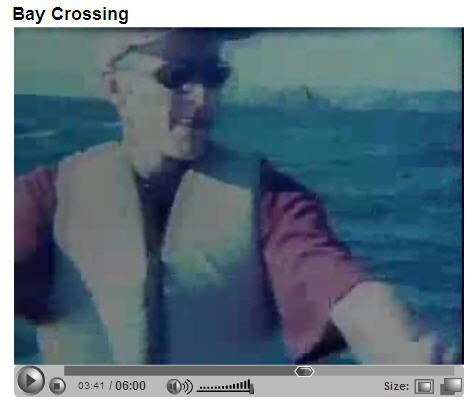
"Bay Crossing" - a film about crossing the San Francisco bay in a homemade rowboat, by Steve MacDonald. The voiceover consists of droll recordings of MacDonald calling around to various public safety officials trying to figure out what permits he needs and "how safe it is." [YouTube] |

Chris Ashley has been posting scans of old children's book covers amid his regular weblog entries. More intriguing design ideas than you can shake a frisket at. The hand-rendered photographic style of A Pony for Linda, above, resembles the high contrast still images of the Cartoon Network show Tom Goes to the Mayor. What doesn't work in an animated cartoon looks great on a kid's book. Also in Ashley's compendium, be sure to check out the endearingly Henry Darger-ish What's Inside of Me?
The image below just hit my email inbox, from Marvelli Gallery in Chelsea. Haven't seen the work in person and know nothing about the artist, but this jpeg, at least, strikes a good bad painting chord. Paging through other work we see a distinct Dana Schutz vibe, but also Judith Linhares with a bit lighter touch, or Laura Owens, if the latter had an ounce of finesse as a painter. Anyway, I'm getting my virtual tasty brushstroke (and nature panic) fixes for the day: Janine Iversen, "Open Longer," 2006, Oil on Canvas, 60 X 78 inches |
Two posts from libertarian blogger Jim Henley crack me up. First, about the Iranian surprise attacks the scaremongers were predicting for August 22, he writes:
And earlier, about ex-CIA analyst Kenneth Pollack, author of the unfortunately influential 2002 book The Threatening Storm: The Case for Invading Iraq:As you know, today was the day that, as predicted by respected Muslim World Experts TM, the apocalyptic regime of Iranian terror masters attacked the West in the name of hastening the coming of the Twelfth Imam. I experienced the carnage first-hand. This morning on the Washington Beltway a guy drove really slow in the left lane - right in front of me. Couldn’t have been going over 50.
I was as resolute in refusing to be cowed by this unprovoked Iranian aggression as I was enraged at the fecklessness of our leaders, who failed to preempt the outrage by launching a major and of course purely defensive war on the Islamic Republic.
But where the craven Bush Administration and its puppeteers on the decadent Left fail America, the blogosphere can fill the void. We are fighting this war too, no less than the meeting planners at the think tanks and the guests on talk shows and the dumpers of fluids into airport bins. So I’m offering this blog item as a sharing - and yes, healing - place. Each of you, please tell us how you coped with the Day of Dodecahedral Doom. Whether acolytes of the Twelfth Imam cut in front of you at Au Bon Pain or put you on hold without asking or failed to note that your blog linked something before any other blogs you happened to notice, no enormity is too, well, enormous, for us to bear, together.
Great stuff.Kenneth Fucking Pollack writes to tell us that civil war in Iraq is a very bad thing. Honest to god, this kind of thing is all the explanation this blog’s frequent resort to profanity requires. Ken baby, it’s your civil war as much as anyone’s. Pollack did more than anyone to encourage the famous “liberal hawks” to provide the bipartisan patina so useful in getting the Iraq invasion started. In the Army, someone would have long since left him alone in the study with a pistol and the discreet interval required to make the only appropriate gesture of regret, genuine atonement being impossible under the circumstances. In Japan he’d be a picture of the different ways light reflects off entrails and cutlery. In Washington, he gets to write new articles, as if he were an epidemiologist and not Typhoid Mary.
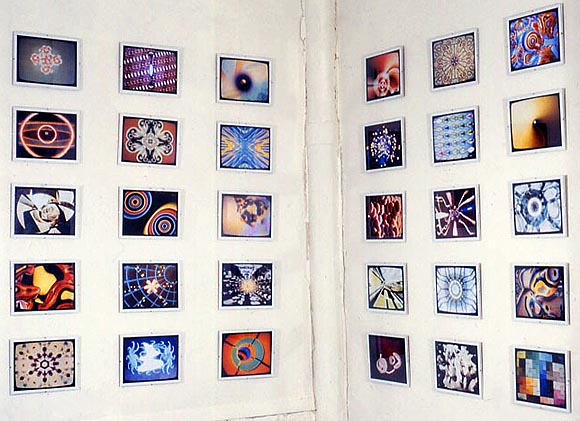
rave video stills - details / more details
Many of the "rave video still" photos above (discussed here, here, and here), which I made around 2000 with a 35 mm camera and a VCR pause button, came from "X-Mix" series of videotapes (see relevant disclaimers at the third link above). These were never shown, I was mostly just interested in them as "found abstraction"--there's some beautiful stuff on those tapes amid a lot of junk.
Cory Arcangel has made a YouTube sighting of one of the tapes. It is a computer animated version of an intense Plastikman track, from the "X-Mix 3" comp. As Cory says, "in the future when we try to describe the 1990s to people, we just need to show them this..."
Update, May 2008: Of course Arcangel's find has been removed from YouTube "at the request of Viacom."
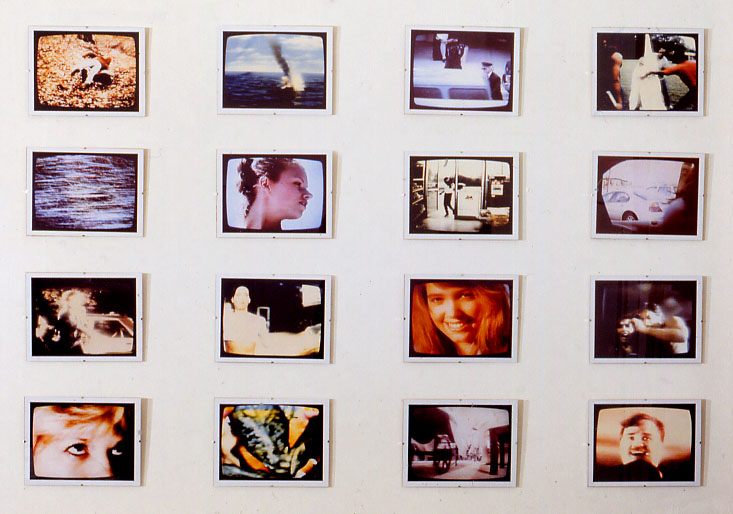
The photos above (that's Set 1, Set 2 is here) elicited some discussion that explained them a bit, and I found out about some other people's tv documentation projects. Everyone's coming at this in a slightly different way--I like that there could be a micro-genre, like monochrome painting. Here is the relevant comment thread, hope you can follow it:
1. detail?
- paul (guest) 8-21-2006 1:12 pm2. You can click on the image and get a bigger view of the group. They're not particularly significant images individually. These are ink jet-prints from the original snapshots I made off the TV (videotapes). The idea was to freeze the frame on "transitional" shots that were never meant to be stills, with an emphasis on picking the most banal subject matter, then thinking about how they did or didn't relate in a grid.
There's really no good way to get this across on the web. And I've never had much response to them in person. But I remain stubbornly attached to the concept and my choices.
- tom moody 8-21-2006 2:28 pm3. cool. I think they're nice. just curious how the grain looks up close.
- paul (guest) 8-21-2006 3:39 pm4. They're pretty TV-grainy, but the prints have a nice quality--semi gloss finish photo paper.
- tom moody 8-21-2006 4:05 pm5. cool. along the same line, one still from each dvd i have rented so far in 06. i've been thinking of how to print it when i'm done. http://www.tinjail.com/tintype/?cat=18
- m.river 8-21-2006 6:53 pm6. we have this blog, we hope you like it..... tvontv.blogspot.com/
- Book House Boys (guest) 8-22-2006 8:10 am7. I suppose I should add that the first steps of my photos were analog. The TV was a CRT. The VCR was paused, I shot the photo with a 35 mm camera, and then took the film to a 24-hour lab. The resulting snapshots were then scanned and printed on nice paper with an Epson 2000P. The result is, I guess, "warmer"--although ideally the negatives would be printed the old way, with an enlarger, chemicals, etc., since the digital part of the process makes the work "colder."
- tom moody 8-22-2006 1:15 pm
Speaking of the Eyebeam Art and Technology Center reBlog, let's all watch Paddy Johnson put her feeds where her mouth is as she guest reBlogs for the next couple of weeks. No, that doesn't mean strapping on the feedbag. A while back she criticized the popular site for regurgitating too many frilly tech items, so they punished her by asking her to reBlog. Essentially what that means is she culls items from a pool of RSS blog "feeds" and posts them with as much text or as many pictures as she wants, in any order--an activity that as explained in the previous post combines blogging, curating, dj'ing and editing. It's different from "regular" blogging in that the material is all right there in the system, ready to be cut and pasted--no surfing around to find content is necessary. Paddy promises to put more art in the "art and technology"; naturally I hope she will consult my 10 Commandment-like "rules for reBlogging" as she invents her own set of guidelines. Here were a few, from '04:
1. reBlogging is definitely an art, somewhere between curating and editing. I believe the Eyebeam reBlog can be as important and genre-defining as any of the major umbrella tech sites, umbrella art sites (if those existed) or heaven forbid, regular news sources, as long as original material from a pool of steady dedicated bloggers is given equal weight to clips. The purely anecdotal has value, as does free lance reporting. Accordingly, I tried to emphasize unique, personal blog writing and research over news items recycled from big media sources. By and large I did not reBlog slashdot, boingboing or kottke, assuming that most people were looking at them anyway. I also avoided the major media feeds, such as NY Times, Yahoo, Wired, for the same reason.Go for it, Paddy!
2. I favored items with text or pictures over blind links with pithy 3-word captions.
3. I tried to keep a balance of tech and art writing.
4. I included a heftier dose of politics because the major media are failing us in that regard and we have to do what we can.
5. I added a few feeds where people are posting original art to the Web: Look, See; SCREENFULL; Wooster Collective.
Tech whiz Michael Frumin is leaving Eyebeam Art and Technology Center for his next gig somewhere in the Matrix, and I want to offer kudos for the work he did over there on 21st Street. His reBlog software, which allows guest bloggers to recycle RSS feeds in a way that combines curating, editing and dj'ing, is Da Bomb: much adopted and imitated. Excellent work, Mike, may you be just as influential in the next job and the next and the next.
Via Wikipedia: "A discussion on how overuse of compression on modern compact discs is ruining the sound and dynamic range with particular reference to Vapor Trails by Rush," by Rip Rowan. Excerpt:
"Here is a side-by-side picture showing a sample of audio from five different Rush CDs. On the top is the latest CD, Vapor Trails (2002). Below that, going back a few years, is a sample from the Counterparts CD (1993). Going back a year is a sample from the Roll The Bones CD (1992). Next is 1985’s Power Windows, the first Rush CD to be recorded entirely digitally. On the bottom is a sample from the Grace Under Pressure CD (1984) which immediately preceded Power Windows and was recorded to analog.
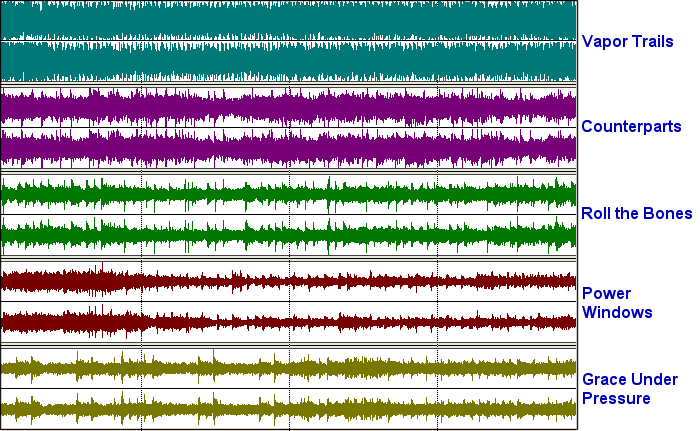
An earlier excerpt:
"Over the past few years, record labels have increasingly attempted to dictate to the artist and producer the target volume level of the CD. For some reason, record labels have it in their head that 'LOUD' equals good, and therefore, 'LOUDER' equals better. Not caring to understand even the basics of audio, these morons simply demand more volume (typically from the mastering engineer) and really don’t understand--or care--about the consequences of their demands.
"Mastering engineers are caught in a Catch-22. If they do not deliver a product that is appropriately LOUD, then they are considered inept by the labels and are shunned. If they refuse to destroy the artist’s music, then they aren’t being 'team players' and quickly fall out of favor. But if they provide what the customer demands (and remember, the label, not the band, is the customer) then they ruin a perfectly good piece of music, and they know that sooner or later, people are going to figure out why the sound is so horrible, and then the mastering engineer will be blacklisted for having followed orders.
"Having said all that I really don’t know what I would do in their shoes. If someone offered YOU the opportunity to master a Rush CD, and then told you that you would have to destroy the sound quality in order to get the job, how would you respond? It isn’t a clear or easy choice."
[G.K. Wicker brought up this issue on this blog awhile back. The comparison chart really hits it home. Another reason to hate the record companies--besides limiting creative freedom, they are conspiring to destroy our hearing. --tm]
"More Marching Morons" [mp3 removed]
"Back-Catalog"
My animation log (updated in clumps).
My (mostly) music blog (as in, my tunes--up to about 170 now, including collaborations and alternate versions).

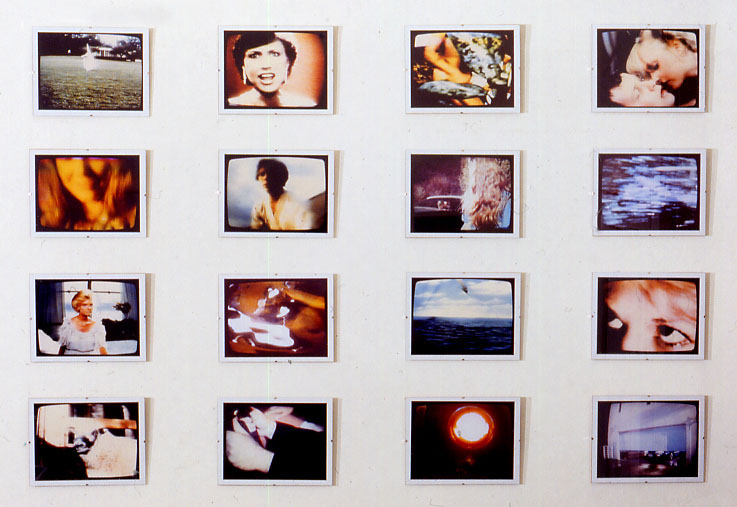
Wikipedia on Concrete TV:
Concrete TV is a public access show in New York City aired on Channel 67, combining violence, sex, pornography, new video, old video in a video collage artform set to music. This half hour program is produced by Ron Rocheleau, known as "Concrete Ron." It is shown Friday nights at 1:30 AM. Episodes are heavily thematically based in 1980s video, hearkening back to the early MTV days, in a mash-up art style.yatta:
Looks like Fleshbot and BoingBoing have found Ron Rocheleau's Concrete TV, perhaps my most favorite show on MNN ever. Created on two VCRs with worn out "Record" and "Pause" buttons, it was The Cut-Up Method of Brion Gysin channeled through video (I think he's moved on to digital tools since I last saw him.) It was collage that could make Nam June Paik quiver. It was montage that could make Eisenstein cry. It mixed good porn, bad movies and even badder music videos in a way that made pre-ritalin MTV look like the work of hacks. Concrete TV was mashup before most of those folks were out of grade school.Concrete TV website (Episode 9 up now in Quicktime)
Episode 8, part 1: [YouTube]
A gem from Manhattan Public Access Cable. The "fast montage of clips" is a staple of art world video (for some reason everyone who does it, and there are hundreds, thinks no one has ever "deconstructed" TV before) but Rocheleau, whose only brush with the art world that I'm aware of was a video window at Cristinerose's West Broadway gallery, is consistently the hardest, fastest, meanest, skankiest, and most relentless of the lot. He's been at this for a decade and a half. He has great comic timing and between bits fills the screen with endless-seeming montages of car crashes, exploding heads, and booty-shaking strippers. All set to a constantly pounding score of rock, hiphop and techno. It really is the ugly essence of American pop culture. An opinion: one reason it would never fly in the galleries is, it's too blue collar and "male." Too honest about about what the state of the culture is really like, in other words. Also, in fairness, it's probably best encountered channel surfing in the dead of night, not on a monitor in a gallery.
Cassie - "Me & U" [YouTube]
The "U" in the case of this video is Cassie's image in the mirror, for whom she sings, mugs winsomely, strips off her shirt, and pours POWERAde on herself in this immortal tribute to narcissism.
I post it as a basis for comparison to Brains' grime-y remix of the same tune (which you can hear on his MySpace page). He slows down the tempo to near-Romilar level and adds drum and bass burbles, videogame stings and a general all purpose bending of time and space. I envy his production skills and the full, liquid sound he gets--blowing out the car speakers bass notwithstanding. The hyperactive annotations to the Cassie lyrics are by London's m.c. Scorcher. Check it out.
More Brains here.




L.M. Cow Gif Four Times
Paddy Johnson on New Media: Why It Doesn't Suck (her title). MTAA on What a New Media Person Has to Do To Cross Over to the Gallery System (my title):
There are some new media artists who cross over and make it look easy. Cory Arcangel and Jennifer & Kevin McCoy come to mind. Arcangel succeeds by acting a bit like a ethnographer who travels into hacker culture and exports the bits that make sense to the art world. The McCoys succeed by addressing the older tradition of film and not letting themselves geek-out when addressing the art world.Speaking as someone with a sneakerhold in both worlds, I'd rather spend my remaining dwindling critical energy explaining the sacred mysteries of the gallery universe to Internet users than trying to tell a gallery person why a spaceship flying over an endlessly scrolling videogame landscape with the caption "lol, usenet" is funny. My sense is the former crowd is genuinely curious while the latter is boastful of its own cyber-ignorance. I will, however, take a crack at defending a Net Art 2.0 piece that I happen to really like. As Paddy describes it,
[The] Guthrie Lonergan piece MySpace Intro Playlist, a curatorial project that consists of 20 [actual, found] MySpace intro videos, inspires the same questions video art has posed to the viewer for years, “Why am I watching this?” To be honest, even as someone who uses these tools on a regular basis, I still have problems figuring out what to do with this piece. It is a cabinet of curiosities I feel I'd rather see on blogger Jason Kottke’s remaindered links, than to have it exist on the more aggrandized Rhizome Timeshares page.I'd say it's the essence of traditional video art, which deals with themes of construction of identity, guerilla theatre, acting out, and "problematizing" the medium (i.e., using it so badly it becomes self-conscious)--except there is no auteur operating the camera and doing bogus sociology. Nevertheless, as a viewer of this "artist as curator" work, as I said in an earlier post, "I feel a bit like James Stewart in Rear Window watching these normal people doing their awkward and occasionally very funny home movie bits to introduce themselves to a million total strangers. It's completely public domain but feels invasive somehow." That's the artist making me uncomfortable.
Update: In fairness to Paddy, I first encountered that piece on Lonergan's page with a link to YouTube. Some art works best "underground"--as in, you found it yourself or through a small network--and doesn't always survive an institutionally enlarged context. Cory Arcangel's Whitney Artport page is one of the few instances I can think of where an artist's anarchic sensibility completely trumped the "normalizing" effect of a museum web page.




"op wheel" (artist unknown) X 4
I have two videos in the upcoming Chicago Underground Film Festival--"Drum Machine" and "End Notes" (w/ jimpunk). Here is the lineup, excerpted from the website:
MOMENTS OF GREATNESS--MUSIC VIDEOSReally proud and excited to be in this company.
Friday August 18
9:45 PM
Theater One, Music Box Theater, 3733 North Southport
Chicago Underground Film Festival
Size matters! Don't miss your chance to check this amazing batch of underground music vids on a screen larger than your toenail. These inspired blasts of low budget, highly creative mindf*cks won't soon be forgotten.
And the music's killer.
Videos include:
Bonnie "Prince" Billy--Horses, directed by Braden King
Black Mountain--Druganaut, directed by Heather Trawick
Jason Forrest--Steppin' Off, directed by Jon Watts
ASCII Rock--My Generation, directed by Yoshi Sodeoka
Bobby Conn and the Glass Gypsies--Home Sweet Home, directed by Usama Alshaibi
The Juan Maclean--Give Me Every Little Thing
End Notes, directed by Tom Moody with Jimpunk
Camero Rougue--Blowin' Yer Top, directed by Ben Redgrave
Animal Collective--The Fickle Cycle, directed by Scott Colburn
The Sea Calls Us Home, directed by Anie Simpson and Seth Kirby
Kaada--Thank You For Giving Me Your Valuable Time, directed by Robert Ruiz De Castilla
FFFF's--Sheets, directed by Brian Henry
The Gossip--Standing in the Way of Control, directed by Wyld File
Drum Machine--Tom Moody
The Mai Shi--Vampire Beats
Negativland--Guns, directed by Peter Neville
Jamie Lidell--New Me, directed by Aleksandra Domanovic
Chemical Brothers--Come Inside, directed by Ik-kyeong Kwon
Starter Set--In Can Can Descent, directed by Lindsay Beamish
Dirty Three with Chan Marshall--Great Waves, directed by Braden King
Antony and the Johnsons--Hope There Is Someone, directed by Glenn Fogel
Thanks to Eyebeam and Rhizome.org* for reblogging the recent post here on Paul Lansky. That writing's been revised a bit, including fixing one unfortunate flub: the phrase "now a kind of parallel universe to the academic camp" in the second paragraph was missing the "the," which made it sound like the post was calling "music department music" camp or kitsch. Some of it is, but not Lansky's. Some more late thoughts on Lansky's essay "The Importance of Being Digital" follow.
A possible contradiction in the essay: Lansky describes in great detail how analog recording errors can mar the pristine perfection of a digital music composition (such errors are called "artifacts," whether analog or digital). He recounts anecdotally, from the bad old days, all the steps involved in transferring a computer music piece of his to vinyl, each of which introduced artifacts. One of his philosophical selling points for digital technology is its ability to make an artifact-free copy, which is then nearly infinitely reproducible on a mass consumption level. (An aside: Lansky's irritability over intrusive sounds explains much about his music, which is remarkably smooth even at its most boisterous.)
Yet while praising the perfect copy Lansky argues for digital music's ability to exploit the "loudspeaker as instrument." In other words, the speaker is not just a window through which a pre-existing sound reality passes. Woofers and tweeters (and the creators who control them) can actively shape and define their own sonic reality. But if that is the case, why is purity of signal such a virtue? Does clarity even exist if no comparison is to be made to a pre-existing sound?
Lansky describes how analog copying procedures carry with them their own history. A grainy xerox of a smudged newspaper image of a black and white photo, for example, tells a story as much as the underlying picture. Setting aside the fact that digital production has its own artifacts, such as the non-stop yodeling of a skipping CD: this "history" can be just as much a part of that "loudspeaker reality" Lansky champions. In other words, it can serve as content to be actively used by the composer, whether through the deliberate introduction of skips and errors into the recording process, or by adding a patina of age or "period" to music, as in the distinctive mellow hum of an old tube amp: a mix of fact and fiction to be sorted out by the listener.
The point of all this being not to challenge Lansky's core arguments but simply to demote "purity of signal" in the pantheon of digital music's virtues, significantly below "ease of copying," manipulatability, and "ability to define its own reality." If clarity has a virtue at all, it is, as Lansky suggests, that it allows infinite cutting and pasting in the composition process without changing the sound in undesired ways due to accumulating artifacts. Being able to create a "richer," "fuller" sound from the rich pallette of prior recorded or previously unrecorded sounds allows the composer to more accurately trigger associations in the listener while at the same time plugging this data into the composition's imaginary patchbay of abstraction and representation.
*Update, 2011: Eyebeam reblog archives are dead. The Rhizome link has been changed to http://rhizome.org/editorial/2006/aug/12/p-lansky-club-vs-academic-electronic-music/. Please note that I authored the post, not Marisa Olson.
I've been going back over my YouTube posts from the past few months--a surprisingly large amount are dead links because they've been removed "for terms of service violations" or "by user." Read: people received greasy lawyer letters and got scared. As if some grainy, tiny crap video from the '70s is something anybody deserves to profit from. Amazing how many creative types don't get the viral thing at all.
Lke Anna Karina's Sweater on Oliver Stone's 9/11 movie:
While it is remarkable that anybody was found alive in [the World Trade Center] rubble (McLoughlin and Jimeno were 2 of only 20), I feel that there's something inherently irresponsible in narrowing the focus in order to create an uplifting, feel-good story. It's as if the film exists in a vacuum, and its refusal to acknowledge facts (both pre- and post-event) is not only naive, but also a bit dangerous. This kind of over-simplification is exactly how Bush & Co. would want you to remember that day. That it was simply an act of 'evil' carried out by individuals who hate our freedom. Is it any wonder that right-wing media outlets are praising the film, or that Paramount hired the same PR firm that brought us the Swift boat campaign against Kerry?Armond White weighs in, building up the Stone movie by bashing United 93:
After 9/11, hucksters have had a huge opportunity to trick filmgoers who are unable to distinguish the solemnity of recent history from tacky Hollywood manipulation. During United 93, when I laughed at its preponderance of action-movie cliches, a middle-class woman chided me to “Be respectful!” Respectful of what? Clumsy exploitation-film mechanics!
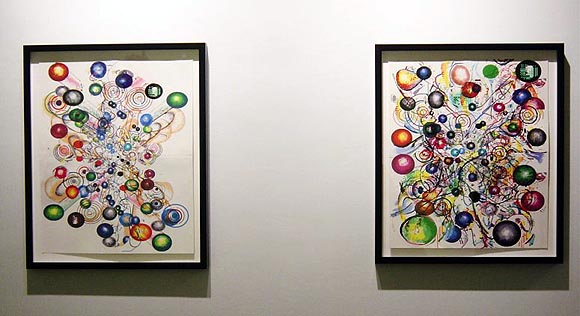
Animated GIF sketchbook, again
Animated GIFs (for eventual videos) based on time lapse documentation of the making of the above works (the animations are still sketches and will change somewhat):
Animated version of image on left (new): [2.7 MB .GIF]
Image on right (previously posted): [2.6 MB .GIF]
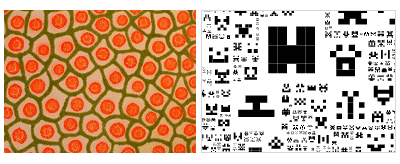
In David Szafranski's paintings, a group of which were linked to here, dataisnature sees some biological and mathematical underpinnings:
It’s the human equivalent of a Diffusion Aggregation Limitation system - whereby particles in solution diffuse randomly until they move near to a piece of solid structure, at which point they come out of solution and form part of the aggregate, resulting in dendritic structures. All of the works have a similar quality and evoke the idea of the human-computer in repetitive sub-routines crystallizing the work into existence.To illustrate the human-computer connection, DIN pairs a detail of a Szafranski painting with a section of a computer-generated drawing by Jared Tarbell (reproduced above). Continuing the conversation and emphasizing the links between "cyber" and "natural" diffusion models, Szafranski, no slouch in the computational department as well being a kick ass painter, has posted a seductive animated GIF [1 MB .GIF] that applies some of the principles of growth and space-filling DIN mentions.
The actual physical makeup of the paintings, though, in contrast to the ethereal GIF and DIN's elegant theory, suggests a more problematic relationship to science. Made of glue, spray paint, and modeling store synthetic grass, in semi-stable combinations certain to give art world painting fetishists fits, the canvases may evoke principles of fractal orderliness on a compositional level, but materially they revel in decay and punk anarchy: the mien of safety pins through the cheek rather than white lab coats.

Miyazaki Forest Spirits - Found GIF
Some thoughts on the amorphous middle ground between between the hissing, honking, and chittering of academic electronic music and the clicks, stabs, and skronks of its club-based variants.
Princeton professor and computer music pioneer Paul Lansky helped lay the groundwork for the economically thriving business of digital sound manipulation, which now includes the time stretching, spectral analysis, morphing techniques being routinely plied at software synthesizer companies like Steinberg and Native Instruments, as further hacked and jacked on thousands of home computer workstations. Lansky's essay The Importance of Being Digital could be a blueprint, or manifesto, for scenesters currently laboring in the trenches. Drawing on his own experience making music with mainframe computers in the '70s, Lansky presents the case for digital production with a theoretical heft usually lacking in chatboard discussions, which are mostly concerned with technical problem-solving: especially compelling is his consideration, based on film theory, of where sound is "located" and the fictions we accept as listeners. Lansky also shines in the studio: hear, for example, his "Night Traffic," 1990 (scroll down for excerpt), which digitally adds pitch and timbre information to the sounds of cars barreling hither and thither on a four lane highway, creating original, listenable music that is both powerful and oddly poignant. Lansky's gravitas and command of the Western tonal pallette puts this closer to the symphonic tradition than any one-off formal experiment.
For a "pop" mirror to Lansky's essay, consider the following review from amazon.com. The topic is the CD Columbia-Princeton Electronic Music Center 1961-1973. A reviewer obviously steeped in that electronic music that evolved out of the club scene--now a kind of parallel universe to the academic camp that is arguably just as vital (see previous posts on the music at Reaktions.com)--yells back across the wormhole to musicians of Lansky's generation who worked with Wollensak tape recorders and refrigerator-sized computers. The review merits sociological attention for the language accommodations the writer makes to explain the academy's music to his own tribe (or I should say, "our own")--mostly cheeky apologies but some deft rock-crit turns of phrase. Lansky, for his part, has made overtures to the popsters from his side of the wormhole, name-checking Autechre and Radiohead (the latter of whom sampled him).
OK, first off, these folks are writing art music, not pop. In fact, they're the folks who brought you "Who Cares If You Listen?" So it's their job not to sound dated, quaint, or collectible, even 30 years (and thousands of Dr. Sample units) later. How well did they do?Some additional thoughts here.
Well, the effect on a dance music-drenched listener like me is kinda like sensory deprivation but more fun. The reptile in my hindbrain hears the electronic tones and expects prominent beat, lots of repetition, and a climactic hook or two. When it fails to get what it expects it zones out, and lets me concentrate on more abstruse things like musical structure, drama, emotion, you know, all the edifying stuff.
All the tracks (sorry, compositions) have that Columbia-Princeton "sound" - sort of a silky, bubbly deluge of myriads of hand-spliced tape snippets and oscillator calibrations. You get the feeling there's a lot of complexity behind the scenes. Despite risk of extra-musical contamination, it's hard to resist looking in the back of the book to find out how they made these pieces.
My favorites follow, your mileage may vary. Charles Dodge's "The Earth's Magnetic Field" features geomagnetic data converted to pitches and sent through a comb filter (a.k.a. flanger with LFO turned off - think Skysaw). "Cortez" by Ingram Marshall is one of those "see how far you can get with one sample" exercises, in this case the syllable "Oh". I like the way things suddenly sweep into focus when the context is revealed. "Out Of Into" by Bulent Arel and Daria Semegen is the soundtrack to an animation, full of fun melodic lines and evocative, dancing timbres. Even my inner reptile liked it.
--John R. Hodgkinson
Jason Uechi's interview with Lansky from '95 (revived in response to this post--cool!) here.
Jacob Weisberg, writing in Slate:
The problem for the Democrats is that the anti-Lieberman insurgents go far beyond simply opposing Bush's faulty rationale for the war, his dishonest argumentation for it, and his incompetent execution of it. Many of them appear not to take the wider, global battle against Islamic fanaticism seriously. They see Iraq purely as a symptom of a cynical and politicized right-wing response to Sept. 11, as opposed to a tragic misstep in a bigger conflict. Substantively, this view indicates a fundamental misapprehension of the problem of terrorism. Politically, it points the way to perpetual Democratic defeat.The dispute here is not between war hawks and America-hating hippies with no grasp of geopolitics, and it's tiresome the way these "centrist" writers keep mischaracterizing the antiwar position. Surely it's a dispute over whether the "global battle against Islamic fanaticism" is a fought like a traditional World War II face-off among nation-states or some 4th Generation combo of politics, trade, cultural persuasion, and, when necessary, intelligently planned commando raids. Right now we're losing in both senses, not thanks to the antiwar movement but because Bush is out of his depth and screwing up massively. If we can't replace him, we need to tie his hands while he is in office, keep him from invading any more countries. Also, it's a dispute over whether pan-Islamic "fascism" is a real threat or just some propaganda shite Christopher Hitchens made up for Bush. Seems as if the "Islamics" do an awful lot of deadly fighting among themselves. On the military side, Steve Gilliard does an excellent job of putting the mushy Weisberg in his place.

New compositions on the Reaktions site, all made with versions of the HERW Modular-Mini synth--a user-built instrument in the Reaktor library. While all Reaktor synths are "modular" and "patchable" in the sense that you can go behind the interface and move parts and wires around, this one has virtual patchcords (and a keyboard) on the front. The look and sound recalls the old modular synths from the '60s and '70s, so not surprisingly the compilation has its nods to Wendy Carlos, Keith Emerson, and the Forbidden Planet score, all updated into the clean, infinitely tweakable digital environment. My favorite .mp3s are by chietronix, r.domain, Joe Risch, and herw (Herwig Krass) himself. The Reaktions group is a bit insular--many restrictions are put on the entries for these compilations, the main one being "made in Reaktor only." I suppose it's a way to really learn the instrument, but it's like Iron Chef having a "soft shell crab battle" where the only ingredient the chefs could use was soft shelled crab. Yes, one is a foodstuff and the other is a totalizing instrument, but while all-Reaktor compositions can be stimulating they frequently need something else.
An earlier report, on the Oki Computer 2 compilation, is here.
The Wilhelm Scream Compilation Video [YouTube]
This audio clip of a man screaming dates back to a '50s western (in which "Wilhelm" is shot by bow and arrow) and is an in-joke among sound effects artists. They stick it in films whenever possible. See an assortment of Wilhelm scream clips in rapid succession. (via Eyebeam reBlog).
Meet Abby Walton. As Travis Hallenbeck says, "a photo a day, same expression."
Juan Cole:
The idea that the whole Eastern Mediterranean had to be polluted, that the Christian Lebanese economy had to be destroyed for the next decade or two, that 900,000 persons had to be rendered homeless, that a whole country had to be pounded into rubble because some Lebanese Shiites voted for Hizbullah in the last election, putting 12 in parliament, is obscene. Bush's glib ignorance is destroying our world. Our children will suffer for it, and perhaps our grandchildren after them.
The New York Times' Bob Herbert on Hillary Clinton and the other "Iraq War Enablers":
So there was Hillary Rodham Clinton grandstanding for the television cameras last week, giving Donald Rumsfeld a carefully scripted chewing out for his role in the Bush administration’s lunatic war in Iraq.This is great, but to the list of "Iraq war enablers" we have to add Herbert's employer the New York Times, which printed false stories about Iraqi superweapons and gleefully got behind Bush's propaganda effort.
Casual viewers could have been forgiven for not realizing that Senator Clinton has long been a supporter of this war, and that even now, with the number of pointless American deaths moving toward 2,600, her primary goal apparently is not to find an end game, but to figure out the most expedient political position to adopt — the one that will do the least damage to her presidential ambitions.
Mrs. Clinton is trying to have it both ways. A couple of months ago, she told a gathering in Washington: “I do not think it is a smart strategy either for the president to continue with his open-ended commitment, which I think does not put enough pressure on the new Iraqi government.” She then added, “Nor do I think it is smart strategy to set a date certain.”
Slick Willie has morphed into Slick Hilly, as the carnival of death in Iraq goes on.
Mrs. Clinton is just one of the many supporters of the war who should have known better from the beginning, and who are now (with the wheels falling off the Iraqi cart and public support for the war plummeting) engaged in the tricky ritual of rationalization.
The favored “it’s not my fault” explanation is that the war was always a grand idea, but the Bush gang was so dopey it fouled up a good thing. If only they’d sent in more troops. If only they hadn’t disbanded Saddam’s army. If only they’d turned right instead of left, or left instead of right, Iraq would be an oil-rich, free-market, democratic paradise, even as we speak.
I’m not trying to give a pass to Mr. Rumsfeld, President Bush, Dick Cheney or any of the rest of the war-loving, high-strutting, muscle-flexing men and women in this most dreadful of administrations. These are the individuals who drove us into the flames of Iraq that so far have consumed scores of thousands of lives. But they could have — and should have — been stopped by wiser heads.
This was a war that never should have happened. There was a legitimate war for the United States to fight in Afghanistan, [Whatever.--tm] but that was not enough for the administration. The Bush gang wanted a war with Iraq, and less-than-courageous politicians like Mrs. Clinton and many others lined up as enablers to help make that war happen.
Many of the Democrats in Congress supported the war only because they remembered the price paid by party members who stood against the first gulf war, a stand that became an embarrassment when the war was easily won and was therefore popular.
Despite the rationalizations now suddenly on the lips of so many, the problem with the current war in Iraq is not the way it was conducted, but the fact of the war itself. It was launched amid blinding, billowing clouds of deceit. There was never any legitimate reason for the war. Iraq had not attacked the U.S. and there was no imminent threat of attack.
The U.S. went in with guns blazing (“shock and awe”) like Matt Dillon shooting up the dusty streets of Dodge City. Only this was the real world, and the result has been unending tragedy.
The American occupation of Iraq was guaranteed, sooner or later, to provoke a sustained and bloody resistance, and it was inevitable that terror would be the resistance’s most effective tool. It was also certain that if the Shiites were empowered, there would be widespread retaliation for their many years of suffering under Saddam, and then the inevitable counterreaction of the suddenly disempowered Sunnis, and so on.
None of this was a secret. The warnings came from around the world before the first shot was ever fired.
Mrs. Clinton, other Democrats and whatever sensible Republicans may still be out there should be getting together to work out a plan for an orderly withdrawal of American forces from Iraq. This was not a war we were ever going to win. It’s time we brought our involvement to an end.
Americans no longer support this war, and there are few things more empty of meaning than dying in a war that one’s fellow citizens — safe at home — have already given up on.
We went into Iraq with bombs falling and guns blazing, insisting all the while that we were bringing the Iraqis the gifts of freedom and democracy. Instead, we gave them terror, chaos and civil war — in other words, a whole new generation of misery and mass death.
Shock and awe, indeed.
"Pop Mechanix" [mp3 removed]
The majority of the sounds were taken off the Internet--various sample sites. Does that mean the samples are public domain? Doubtful. Anyway, the material is reassembled more or less from the ground up. The piece starts off as a rather blunt techno stomper (built around three notes from the "classic" Roland Juno), and gradually gets more percussive and atmospheric, without ever quite losing the beat (I hope).
From an AP article (probably behind the Salon firewall)--not sure if the bolded statement is wry humor, fear of the Christian right, or both:
Previously hidden writings of the ancient Greek mathematician Archimedes are being uncovered with powerful X-ray beams nearly 800 years after a Christian monk scrubbed off the text and wrote over it with prayers.What's wrong with "...during the Middle Ages, when superstition largely replaced science"?
Over the past week, researchers at Stanford University's Linear Accelerator Center in Menlo Park have been using X-rays to decipher a fragile 10th century manuscript that contains the only copies of some of Archimedes' most important works.
[...]
Born in the 3rd century B.C., Archimedes is considered one of ancient Greece's greatest mathematicians, perhaps best known for discovering the principle of buoyancy while taking a bath.
The 174-page manuscript, known as the Archimedes Palimpsest, contains the only copies of treatises on flotation, gravity and mathematics. Scholars believe a scribe copied them onto the goatskin parchment from the original Greek scrolls.
Three centuries later, a monk scrubbed off the Archimedes text and used the parchment to write prayers at a time when the Greek mathematician's work was less appreciated. In the early 20th century, forgers tried to boost the manuscript's value by painting religious imagery on some of the pages.
















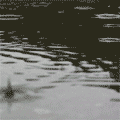







Paul Pfeiffer does Paris Hilton...

Animated GIF sketchbook, Return of the
I'm in a show next month dealing with the theme of place, including virtual places (more specifics to follow). I'm proposing an artwork that has no "center," in the sense that it is located in several media without any clear hierarchy. I'm going to use the two pieces that were done for my show at And/Or Gallery earlier this year (above--photo courtesy the gallery) and exist as framed works on paper made with a home computer (the old MSPaintbrush program, with multiple passes through the printer). Those pieces are an "incarnation" of the work. They were documented step by step on my blog, so another "incarnation" would be a list of URLs in the title card indicating the ongoing Web presence of the works. Lastly, there would be time-lapse videos of the original documentation photos, continously looping DVDs playing on TVs or monitors in the gallery. Here's a "sketch" of the animated GIF that would become one of the vids (a sketch because it will change somewhat): [2.6 MB .GIF]
I'll update with the other "sketch" once it's completed.

dude gets whupped - artist unknown
GIF of a kitten struggling to stay awake. If everybody would just look at this every minute of every day, there'd be no more war.
"Hey" [mp3 removed]
The sample of a guy saying "Hey!" was snipped from a song on the Grime Time website. Most of the percussion is apparently echolocation sounds made by bats, from a Native Instruments Battery kit crafted by Plaid. So, lots of vocals here--a first. The rest of it is semi-familiar club stabs.
Haven't read all of this Vanity Fair article yet, but apparently the gist of it is that the 9/11 hijackers did have help from the US government--not in the form of a conspiratorial green light but a Keystone Kops leadership vacuum. According to a "complete" set of tapes listened to by the VF reporter, the air defense agency NORAD was scrambling jets late, and to the wrong places, as it followed up on rumors of 10 possible hijackings the morning of 9/11. By 9/12 it had 300 jets aloft over various US cities but when its efforts mattered most, all the hijackers slipped through our air defenses.
Fortunately, Americans knew that the biggest problem of 9/11 was not a "worldwide terrorist network based in Afghanistan" but our own government's incompetence in the face of a spectacular, tragic one-off incident. The people rose up as one, and pressured Congress to impeach Bush and "shut down the government" through the power of the purse, until more competent leadership could be put in key Executive Branch positions. A triumph for our democratic system: It would have been doubly tragic if the US had gone off half cocked and invaded sovereign nations, weakening our military even further.
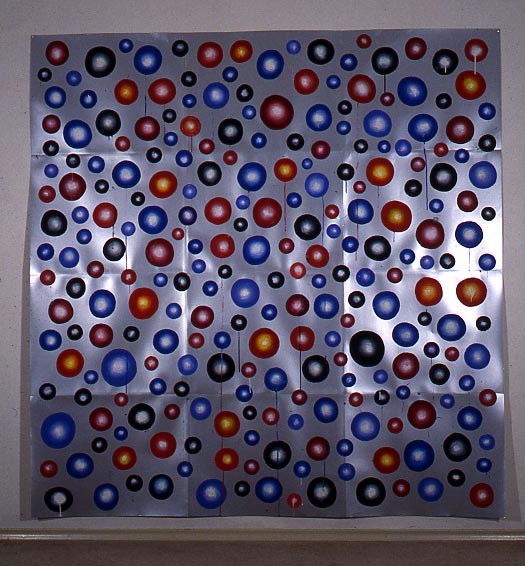
Psychic Highway, 1994, gouache on aluminum-coated paper, linen tape [along seams on back], 81" x 78" (destroyed 2002)
Getting the water-based gouache paints to stick on that metallic surface was the challenge of a lifetime. By 2002 so much had cracked off it the piece had to go to the landfill. The drips are all fake--to give the look of zestful spontaneity. A bit Scharfish but without his commitment to creating a fine, permanent object.
Dennis Hollingsworth's paintings have been mentioned here a few times. What follows is an attempt to describe the work and answer some criticisms of it.
Let's start by saying what it definitely isn't:
"just about paint"
That's like saying that The Rite of Spring is just about musical notes. If you think the canvases are some dull, said-a-million-times statement about materiality, as some commenters have suggested, please look again and remember that the whorls, blobs, and explosions are not mere accidents but also a record of events shaped by a human consciousness. Not a vision of an animate cosmos as literal as, say, Blake's, but still a teeming universe of suggestive contours and textures, thwarting powers of speech--a morphed mashup of animals, ghosts, genetic mutations, war wounds, and impossibly tangled plant life, at least in this viewer's art-prompted reckoning.
One could say in '80s jargon that his thick paint is a hyperrealized version of past expressionist art--a Baudrillard term meaning roughly "on steroids." But to call it pornographic, as one commenter did, rather ignores the joyful, non-synthetic element. The artist says the work is an "affirmation of paint" after the negation of the post-Modern years. But does that make it Modernist? If so, it's closer to surreal, abject side of Modernism that Clement Greenberg and other 20th Century critics tried to edit out of history. The colors may be joyful, but the sea urchin-like blobs that cling to everything seem vaguely alien and parasitic. The intricate cutting and slicing of organic forms suggests an anatomist's inner burrowing.
And lastly you have the linguistic side of Hollingsworth's work--a hermetic system of recurring elements (which have names--see Scott Speh's review) that serve as a private lexicon in a state of perpetual breakdown and reshuffling. This recombinant practice hews closer to postmodernism than the Modernism that forever proclaimed its abstract vocabularies as new and scientifically derived. Hollingsworth's work is aware of nonrepresentational conventions and builds on the limited vocabularies of Peter Halley, Jonathan Lasker, et al, who in turn built on the Abstract Expressionists. Yet ultimately his fearlessness to engage in actual, dense, convoluted, expressionistic (or expression-like) paint handling gives him a richer and more varied range of iconography than those predecessor "deconstructors."
Update: Revised in Feb. 2009.

Gro-Rabbit--artist and actual title unknown
Talking about art conservation issues makes me miserable. It's soul-deadening and antithetical to art.
